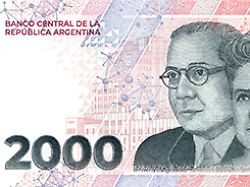Because of high inflation
Argentina introduces new bank note
5/22/2023 8:52 p.m
Even relatively small purchases require large piles of cash in Argentina. The new 2000 pesos note will probably only help a little in view of the serious problems. The central bank can’t keep up with the printing anyway.
In the face of high inflation, Argentina has introduced a new banknote for the first time in five and a half years. The 2,000 pesos bills have been in circulation since Monday, the South American country’s central bank announced. The doctors Cecilia Grierson and Ramón Carrillo and the facade of the Malbrán Research Institute can be seen on the now largest banknote.
Until now, the 1000 pesos note was the largest banknote in Argentina. It was introduced in November 2017. Since the inflation rate is currently over 100 percent, its value has fallen sharply. According to the official exchange rate, 1000 pesos correspond to about 3.95 euros, on the black market 1000 pesos even trade for only 1.90 euros.
In everyday life, the low value of banknotes poses numerous problems for Argentines: large stacks of cash are needed even for relatively small purchases. In addition, the central bank can hardly keep up with the printing of new banknotes. Most recently, she therefore placed print orders in France and Malta. The 2,000 pesos note shouldn’t really help either: it’s officially worth 7.90 euros or 3.80 euros on the black market.
Action in Argentina shows a parallel to the hyperinflation of 100 years ago. At that time, attempts were also made in Germany to make do with the printing of new banknotes. The whole thing took on extreme proportions: banknotes worth several trillion Reichsmarks were even put into circulation, but they were hardly worth more than the paper they were printed on.
Argentina is suffering from a serious crisis
The inflation rate in Argentina is one of the highest in the world. To fund the budget deficit, the central bank is constantly printing fresh money. The second largest economy in South America suffers from a bloated state apparatus, low industrial productivity and a large shadow economy that deprives the state of a lot of tax revenue. The national currency, the peso, continues to depreciate against the US dollar, the mountain of debt is constantly growing and the fear of a new national bankruptcy is spreading.
In the fight against hyperinflation, more and more blatant emergency measures are being taken, which are apparently only intended to delay the economic collapse for a few more months. Recently there have been reports that Argentina wants to raise interest rates to 97 percent.
